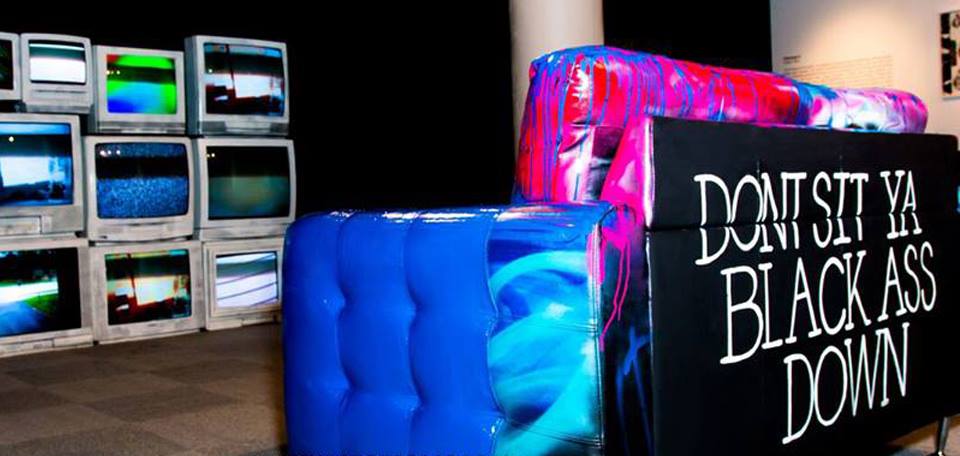Mainstream American media has a shameful record of misrepresenting black Americans, their lives and stories in ways that are either outright racist or implied through more subtle, coded language and images. Artist Justin Adu’s African Amedia exhibit, at the African American Museum of Dallas, seeks to address these negative portrayals through the use of multimedia art. I recently talked to Adu about his project and why it’s so relevant today.
Bani Amor: So tell us about yourself and the art exhibition and performance piece that is African Amedia.
Justin Adu: As an artist, my biggest goal is to creatively share stories with the world. With the recent issues of police brutality and everything happening in the media, I wanted to show people a different perspective of African Americans. I came up with African Amedia, an art exhibition and performance piece that deals with the portrayals of African Americans in the media.
Bani: Did you see something especially racist on TV that moved you to start this project, or was it something you had been wanting to do even before the murder of Michael Brown galvanized the Black Lives Matter movement?
Adu: Well, the idea of the portrayal of African-Americans is something that we have been dealing with well before 2015, so that was always something that I wanted to touch on. I began to see how the news media was going out of their way to cover these stories that dealt with police brutality and putting their own spin on them. I wanted to show the media how they were corrupting society with their misrepresentation of African-Americans.
This spin was shown on CNN and FOX News through the use of the word “thug.” Calling passionate African-Americans fighting for a cause “thugs” is insane. Then, more recently with the church shooting in South Carolina, the media goes directly to the word “mental illness” after a terrorist carried out a race-based attack on African-Americans.
I wanted to show the media how they were corrupting society with their misrepresentation of African-Americans.
Bani: The goal of your project was to help African Americans to see themselves and each other beyond the negative portrayals the mainstream media pushes. To what extent do you believe the media harms the self-perceptions of African-Americans?
Adu: The bigger question is how much control do African Americans or people of color have over these channels. Burger King reached out to Mary J. Blige to do a chicken commercial, which was set up to be an overall stereotypical depiction. That’s why I also want African-Americans to not feed into those stereotypes, nor support them.
Bani: So your project is also meant to address the complicity of African-Americans feeding into the negative portrayals depicted by mainstream media?
Adu: Exactly! It takes action to stop these negative portrayals. Something that you will notice in the exhibit is a set of TVs that are on rotation, showing a loop of images of African-Americans being mistreated. I’m saying that we should not sit and do nothing when we see these images.
Bani: Aside from celebrities like MJB, how much power and control do you think the majority of African-Americans have in framing the narratives about themselves in mainstream media? And how do you suggest they could be fought?
Adu: I don’t think that we have much control at all, which has opened my eyes up as a person who is behind the camera a lot. In terms of major media outlets and technology, there are not enough people of color making power moves, and that’s why I admire black directors, Oprah , Diddy, Revolt, and so many other African-Americans creating outlets for us to tell our own truths. My suggestion is that African-Americans sit in that more and create. Tell our stories the way they should be told. I enjoyed directing, producing, and writing African Amedia and creating the work for it, because it allowed me to tell our truths.
That’s why I also want African-Americans to not feed into those stereotypes, nor support them.
Bani: What has the reception been like in response to this project? Anything that surprised, challenged, or enlightened you?
Adu: Yes! It’s been great. A lot of people were able to view the current state of African-Americans from a different perspective. The biggest thing that brings a smile to my face is seeing people from all walks of life attend.
Bani: Awesome. Do you have any final thoughts to add before we wrap up?
Adu: I want people to understand the importance of continuing to talk about the issue of race, because I think it is a conversation that people are still shying away from. The more that we don’t talk about it, the more people will never know the problems we are facing. Hopefully, through African Amedia, people will have a conversation about race and be able to come up with an action plan to address the problems we’re talking about.
African Amedia is at the African American Museum of Dallas until October 25, 2015.
